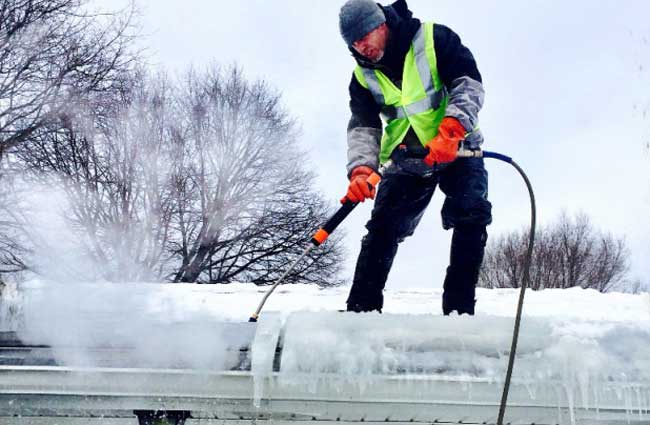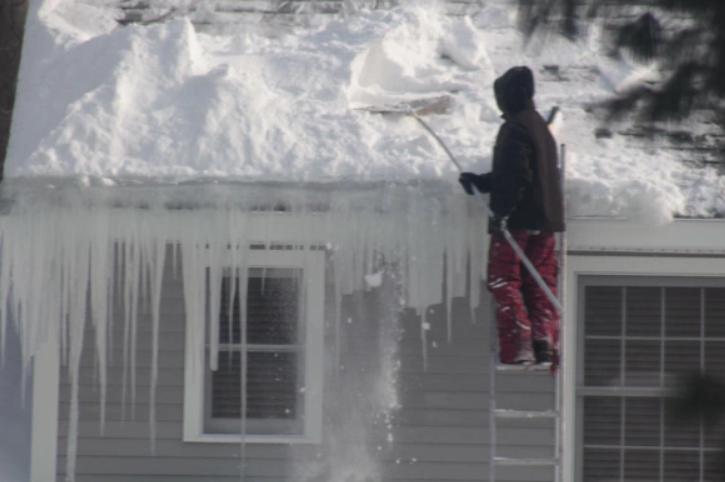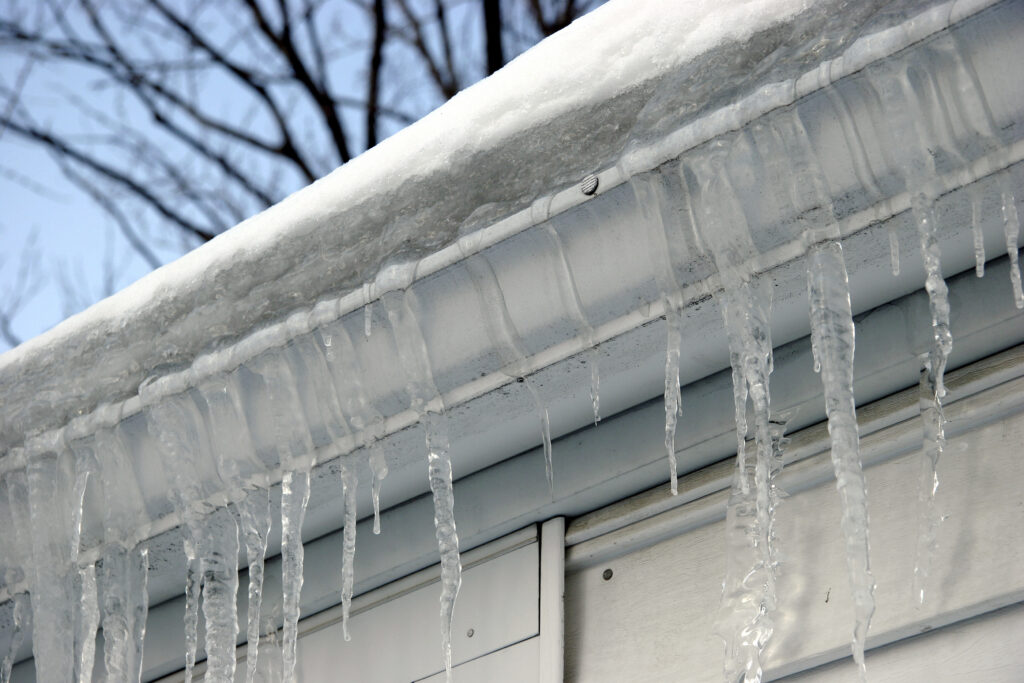Top Rated Ice Dam Removal Service
“Melting ice dam on roof” can be a huge problem and often leads to water damage in the home. If you’re dealing with it, it’s essential to remove it quickly. You may be able to do this yourself, or you may need to call in professionals. That’s why it’s crucial to find a reputable and experienced ice dam removal service to take care of the job for you.
Ice dam removal companies near me offer various services to help you remove ice dams from your home. Ice dam removal is essential to prevent water damage to your roof and property. It is also necessary to ensure the job is done correctly, as removing an ice dam improperly can cause further damage.
Looking for a Top Rated Ice Removal Company? Call Us Today at (630) 922-3131!
Gutter Medics, is your top-rated choice for all your ice dam removal needs in Downers Grove, IL. Gutter Medics can assist you in removing ice dams from your roof. We have the experience and expertise necessary to quickly and safely get the job done. Please contact our nearest service area.
Have any questions about Gutter Medics services? Read our FAQ section.

Ice Dams: Formation And Prevention
When a roof’s edge builds ice, ice dams are form, preventing melting snow (water) from flowing away. Back-up water behind a dam can cause a house to leak water and damage its siding, ceiling, insulation, and other areas.
When the snow on the top, warmer side of a roof melts away and flows down to the colder overhang of the eaves, it refreezes. Ice forms a blockage as it accumulates on the top, making additional snowmelt impossible to drain.
These ice-melts build up ice under the roof shingles. It drenches the roof sheathing and gets into the attic. These ice-melts soak the insulation (reducing its efficiency). Your living area could be affected by this leak now that it has penetrated the ceiling drywall below. Additionally, ice dams can damage the gutters and even pose a safety hazard to the people below. A large ice dam could cause interior water damage or gutter damage.
In attics, ice dams only form if the space beneath the roof deck is above freezing. The heat beneath the roof melts the snow on the top, causing water to flow down the roofline until it reaches the eaves structure, which freezes. Due to snow’s insulation properties, ice dams often form after a heavy snowfall. Warm air trapped beneath the snow layer causes it to melt.
Water that falls on the roof deck or in the attic and remains cold will not melt snow, preventing the water necessary for ice dam formation. There are various ways we can avoid ice dams:
- Ventilation beneath the roof deck prevents the colder air from warming above the freezing point and melting the roof’s snow.
- Insulation of the ceiling beneath the attic doesn’t allow cold air to rise into the space and melt the snow.
- Remove any heat sources that may cause the attic to get too hot.
DIY Ice Dam Removal
Ice dam removal DIY is a popular option for homeowners who want to fix the problem independently. However, it is essential to be careful when removing an ice dam as there is a risk of injury. Suppose you are not comfortable removing the ice dam yourself. In that case, you can hire a professional ice dam removal service near me. Many companies offer this service.
For further information, call us at (630) 922-3131.

How To Remove Ice Dams On Your Roof: 5 DIY Easy Steps
1. Get Rid Of Its Fuel Source
Ice dams continue to form over time if the snow and ice on your roof are left alone. The first step is to use a snow rake, an extension rake that can reach up to a length of around 17 feet. Using this rake, scrape the existing snowpack from your roof by standing on the ground (not on the top of the ladder). Use a pulling motion rather than a side-to-side motion, as that could disturb the shingles.
2. Chip Away
Ideally, ice picks or awls should perform this task, but a crowbar or hatchet will also be helpful. You can start at the gutter and work your way up the roof. Make your way up a stabilized ladder or other sturdy object as you chip away at the ice buildup (be careful not to damage the top). Remove just enough ice to allow the melted snow and ice to flow through a channel.
3. Utilize A Chemical De-Icer Product
A chemical de-icer is mostly tablet or crystal form sold at hardware and house-improvement retailers. Urea fertilizers, ammonium sulfate, calcium magnesium acetate, and potassium chloride are just a few chemicals present. Put the chemical at the top of the ice in your gutter; then sprinkle or distribute it as directed on the label. Eventually, the ice will melt, and all substances will drain from your gutters.
4. Reuse Old Stockings Or Pantyhose
Seal off the ends of these garments after filling them with chemical de-icer. Place them atop your iced gutters. Allow the contents to seep through the stockings or hose and melt the ice. It might take some time and requires rearranging some clothes.
5. Apply Warm Water
While this is merely a short-term measure, it can quickly make a difference. Fill a sprayer (large spray bottle, lawn fertilizer canister, etc.) with hot or warm water. And to break down the ice, spray this warm water to ice dams.
However, unless there is a warming trend in your area, the heated water will soon freeze – so use it in conjunction with the other methods above. Water is the most severe hazard to houses with ice dams. As the ice collects behind the roof and comes into touch with heated air within the home, it melts.

Ice Dam Damage
Damage to ice dams can take many forms. It goes far beyond simply the extra weight ice puts on the roof. The following are examples of the damage that ice dams can do.
1. Water Damage
Water is the most severe hazard to houses with ice dams. As the ice collects behind the roof and comes in touch with heated air within the home, it melts. The water that results from this process might cause damage to ceilings, walls, flooring, and insulation. Buckled floors, ceilings, and unstable walls are possible consequences of significant water damage.
2. Mold
When water gets stuck, mold may grow—producing the more harmful black mold, which is difficult to remove.
3. Roof Damage
Ice may damage or even tear away shingles as it accumulates under them. Ice dam removal must occur before the resulting water exposure threatens the roof’s structural integrity. A homeowner may need to replace his/her roof if the damage is severe.
4. Gutter Damage
Gutter rip-offs are common due to ice dams. While gutters might stay in place all season, they often warp and bend out of shape from being pushed by ice dams.
5. Exterior Damage
Water can cause significant damage to siding, soffits, fascia, and even eaves. The torn gutters may result in damaged wood. If ice dams remains in your gutters, the ice would melt and go through any wood behind them.
Generally, large homes take longer to remove ice dams. On the other hand, just because you have a smaller home does not mean the process will be faster. Ramblers and other tiny houses can accumulate enormous amounts of vertical ice (ice that climbs up the roof rather than just along the edge). Smaller homes with vertically forming ice dams can take just as long (or longer) to remove as larger homes with more spread-out ice dams.
You should call a professional like Gutter Medics, to get rid of ice dams. If they have formed in your home this winter, make sure that enough heat is escaping your house for the snow on your roof to melt before it starts an ice dam.
Looking for a Top Rated Ice Removal Company? Call Us Today at (630) 922-3131!

